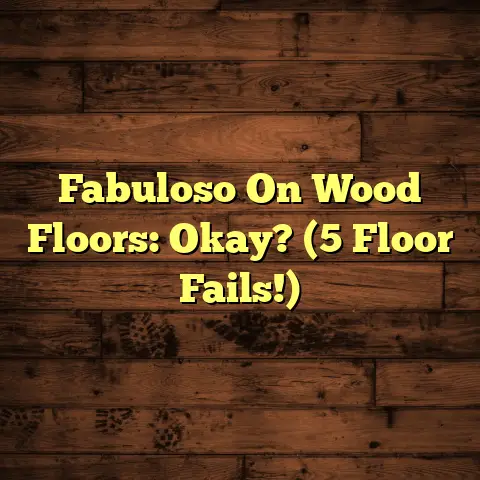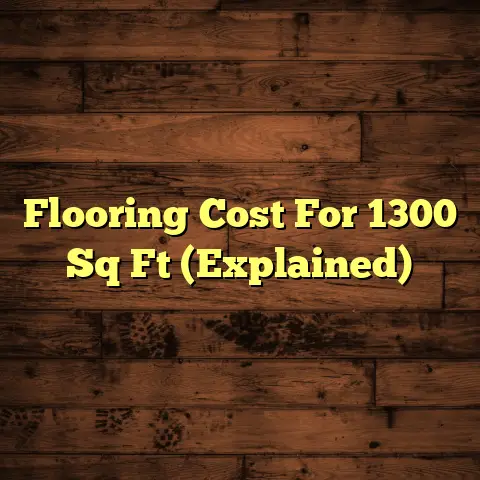Stop Chair Scratches Now! (3 Protective Glides!)
I get it. It’s the ultimate paradox: we want comfort, but we also want to preserve our homes. That’s where protective glides come in.
Think of them as tiny superheroes for your floors, battling the invisible enemy of chair leg scratches. In this article, I’m going to walk you through the three best types of protective glides, so you can say goodbye to those unsightly marks and hello to peace of mind.
Section 1: The Impact of Chair Scratches on Flooring
Let’s face it, chair scratches aren’t just a minor annoyance; they can seriously impact your flooring. I’ve seen it all in my years as a flooring contractor, from barely-there scuffs to deep gouges that require costly repairs.
Hardwood: These floors are particularly vulnerable. Each scratch compromises the finish, exposing the wood to moisture and further damage. According to the National Wood Flooring Association (NWFA), refinishing hardwood floors can cost anywhere from $3 to $8 per square foot. Ouch!
Laminate: While more scratch-resistant than hardwood, laminate can still suffer. Scratches can expose the core layer, leading to swelling and irreversible damage. Replacement costs can range from $2 to $5 per square foot, not including labor.
Tile: You might think tile is invincible, but think again. While less prone to scratching, chairs can still chip or crack tile, especially if there’s any grit or debris trapped underneath. Replacing a single tile can be a hassle, and finding a perfect match can be tricky.
Carpet: While scratches aren’t a concern, chair legs can crush carpet fibers, leading to flattened, worn-out spots. This can affect the overall appearance and lifespan of your carpet.
But it’s not just about the money, is it? Scratched floors can impact your mental well-being. Aesthetics play a huge role in how we feel about our living environment. Who wants to relax in a space marred by unsightly damage?
Section 2: Understanding Protective Glides
So, what are these magical “protective glides” I keep talking about? Simply put, they’re small pads or caps that attach to the bottom of your chair legs, creating a barrier between the chair and the floor.
They come in various materials, each with its own set of pros and cons:
-
Felt: Soft, gentle, and ideal for hard surfaces like hardwood and laminate.
-
Rubber: Durable, versatile, and great for tile, vinyl, and even carpet.
-
Plastic: Economical, practical, and suitable for high-traffic areas.
Choosing the right glide for your specific flooring is crucial. Using the wrong type can actually cause damage!
Here’s a quick guide:
| Flooring Type | Recommended Glide |
|---|---|
| Hardwood | Felt Pads |
| Laminate | Felt Pads |
| Tile | Rubber Caps |
| Vinyl | Rubber Caps |
| Carpet | Rubber Caps or Plastic Glides |
Section 3: Glide #1 – Felt Pads: Soft Protection for Hard Surfaces
Felt pads are my go-to recommendation for hardwood and laminate floors. They’re made from compressed felt, which is incredibly soft and gentle. They act like tiny cushions, preventing scratches and scuffs as your chairs move.
Benefits of Felt Pads:
-
Excellent Scratch Protection: The soft felt glides smoothly over hard surfaces.
-
Noise Reduction: They help dampen the sound of chairs moving, creating a quieter environment.
-
Easy Installation: Most felt pads come with an adhesive backing, making them super easy to apply.
I remember one client, Sarah, who had beautiful, newly installed hardwood floors. She was terrified of scratching them, especially with her active kids constantly moving chairs around. I recommended felt pads, and she was amazed at the difference. “It’s like the chairs are floating!” she told me.
How to Apply Felt Pads:
- Clean the chair legs thoroughly.
- Peel off the backing from the felt pad.
- Center the pad on the bottom of the chair leg.
- Press firmly to ensure a secure bond.
Maintenance and Replacement:
Felt pads wear down over time, so it’s important to check them regularly. I recommend replacing them every 6-12 months, depending on how frequently the chairs are used. You can find replacement felt pads at most hardware stores or online retailers.
Section 4: Glide #2 – Rubber Caps: The Versatile Shield
Rubber caps are the chameleons of the glide world. They’re incredibly versatile and can be used on a variety of flooring types, including tile, vinyl, and even carpet.
Why Rubber?
-
Durability: Rubber is a tough material that can withstand a lot of wear and tear.
-
Grip: Rubber provides excellent grip, preventing chairs from sliding around too much.
-
Shock Absorption: Rubber helps absorb impact, reducing the risk of cracking or chipping tile.
I often recommend rubber caps for dining rooms, where chairs are frequently moved. They provide a good balance of protection and stability.
Installation Techniques:
Rubber caps come in various styles, including slip-on and nail-on. Slip-on caps are easy to install, while nail-on caps provide a more secure fit. Make sure to choose the right size cap for your chair legs.
When Rubber Outperforms Felt:
While felt pads are great for hardwood and laminate, rubber caps are often a better choice for tile and vinyl. Felt can sometimes trap dirt and debris, which can then scratch these surfaces. Rubber is easier to clean and less likely to trap debris.
Section 5: Glide #3 – Plastic Glides: The Economical Choice
Plastic glides are the budget-friendly option for flooring protection. They’re simple, effective, and ideal for high-traffic areas where chairs are frequently moved, such as dining rooms and offices.
Benefits of Plastic Glides:
-
Affordability: Plastic glides are the most economical option.
-
Durability: While not as durable as rubber, plastic glides can still withstand a good amount of wear and tear.
-
Low Friction: Plastic glides allow chairs to slide easily, which can be helpful in certain situations.
I often recommend plastic glides for offices, where chairs are constantly being moved around. They provide a good level of protection without breaking the bank.
Selecting the Right Size and Type:
Plastic glides come in various sizes and shapes. Make sure to choose a glide that fits snugly on your chair legs. Some plastic glides also have a swivel base, which allows the chair to move more freely.
Section 6: Installation and Maintenance of Protective Glides
Okay, so you’ve chosen your glides. Now what? Let’s talk installation and maintenance.
Installation:
- Measure: Measure the diameter of your chair legs to ensure you buy the correct size glides.
- Clean: Clean the bottom of your chair legs thoroughly. Remove any dirt, dust, or old adhesive.
- Attach: Depending on the type of glide, either peel and stick, slip-on, or nail the glide to the chair leg. Make sure it’s centered and secure.
Maintenance:
- Regular Checks: Inspect your glides regularly for wear and tear. Replace them as needed.
- Cleaning: Clean your glides periodically to remove dirt and debris. A damp cloth is usually sufficient.
- Re-Adhesive: For stick-on glides, consider using a stronger adhesive if they start to come loose.
Section 7: Beyond Glides: Additional Strategies for Flooring Protection
While protective glides are essential, they’re not the only weapon in your arsenal. Here are a few additional strategies for preventing chair scratches:
- Area Rugs: Place area rugs under your dining table or in high-traffic areas. They provide a soft barrier between the chair legs and the floor.
- Chair Mats: Use chair mats under office chairs to protect the floor from rolling casters.
- Mindful Placement: Be mindful of how you place your furniture. Avoid placing chairs in areas where they’re likely to be dragged or bumped.
Conclusion: Embracing Comfort Without Compromise
So there you have it: my comprehensive guide to stopping chair scratches in their tracks! Protecting your floors doesn’t have to be a daunting task. By choosing the right protective glides and implementing a few additional strategies, you can enjoy your comfort without compromising the beauty of your home.
Remember, a little prevention goes a long way. Take action today and transform your home into a sanctuary of comfort and beauty, where chair scratches are a thing of the past. Go ahead, sink into that armchair and relax – you’ve earned it!





